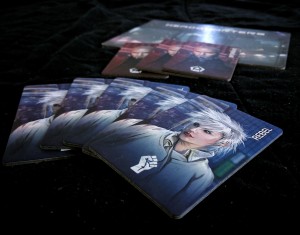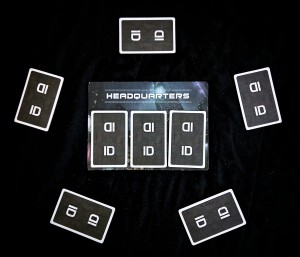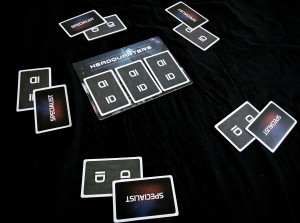Okay, Imagine this. You are a revolutionary in a dystopian future. The the government is run by a massive monopoly of corrupt corporations bent on using the population as an easy source of income to satisfy their corrupt and greedy desires. You have put together an elite team that you not only believe is capable of overthrowing said government, but have also earned your implicit trust. But… one day, the evening before the revolution is set to take place you learn that one or more of you is in fact an informant for the government! However could you have missed it? Who could it possibly be?
Or was it you all along…

This is the plot behind Indie Boards and Cards newest release One Night Revolution. A fifteen minute social deduction game for three to ten players which mixes the theme and ideals of The Resistance with the chaotic card swapping mechanics of One Night Ultimate Werewolf. If you have not played either of these games, I highly recommend you check them out. I will proceed with the game explanation assuming you have not played either of these, and review the game on it’s own merit. Though I will make references to those games near the end of the review during the opinion segment. If you already know how the game is played, feel absolutely free to skip to the opinion portion of this review.
Rules
The game begins with set up, determined by how many players will be accompanying you. You begin by handing out the basic roles, known as IDs. You are either an Agent or an Informant. Classic good guys vs. bad guys. The IDs are gathered; one agent for each player plus three informant cards.
Shuffle and deal, then and the remaining three cards will be sent to the HQ face-down.
After the IDs are dealt every player receives a specialist card. This card will tell you your night time action.
Here are the Specialist actions in a basic game:
Observer: Does not have an action.
Inquisitor: Looks at one other players ID card.
Signaler*: Pokes a player on their right or left.
Reassigner*: Switches two other Players ID cards.
Thief: Steals another players ID, views it, and swaps it for theirs.
* If you are a Signaler or a Reassigner, and you also happen to be an Informant, you will have a different action. Informant Signalers poke ONLY another informant and ONLY if they are directly next to one. If there are no informants next to you, you do nothing. Informant Reassigners replace an agents ID with an ID card from the HQ in the center. It’s worth noting that this is the only time, in a standard game, that any card in the HQ is touched or changed.
Once the specialist cards are dealt, one token for each specialist card in the game is placed around the HQ. These will be important later.
Then the game begins. The game is played in four phases. The Night Phase, The Declaration Phase, The Discussion Phase, and The Vote. Keep in mind, these are terms I have attributed to these phases to make explanation easier. you won’t find them referenced in the rulebook. Here are the phases broken down.
The Night Phase: The randomly selected leader calls for players to close their eyes. The leader will then call out for the informants to open their eyes and make themselves known to each other. They will then close their eyes. At this point the leader will take his action, once completed he will call out “Action Complete.” This signals the person to the leaders left to begin their action. Once completed they will also call out “Action Complete.” This continues until all players have had their actions. At this point the leader will then call for everyone to open their eyes.
(From this point on, no one may view their own ID card.)
The Declaration Phase: Once all night actions are done and everyone has their eyes open, each player will claim one specialist token. By doing this they are claiming the specialist action they carried out during the night. At times, because there is only one specialist token respective to each specialist card in play, players may need to take a specialist token from another player who first claimed the action. In this case the first player would claim one of the remaining tokens from the center. There should be minimal discussion during this phase.
The Discussion Phase: Discussion is had.
The Vote: Players vote simultaneously on who they believe should be killed. If there is a tie, both players are killed. If a single Informant is killed, the Agents win. Otherwise, the Informants win.
Review
This game is basically a sequel to One Night Ultimate Werewolf. The Resistance theme is there and it works well to accommodate the new mechanics but what I really find interesting are the things they improved. One Night Ultimate Werewolf has two major issues: The sounds during the night phase, and the lack of a good starting point for discussion.
In ONUW, during the night phase, you will almost always hear sounds when people take their actions. This gives you clues during the night as to what you heard and who did which actions. This actually isn’t too bad in general but once everyone wakes up they have to decide whether to share that information or not. Most ONUW games I’ve played start with an awkward moment of silence while players decide who will speak first. If people choose to reveal their actions or not. Its usually a slow and painful start, but once that is done the game plays wonderfully!
One Night Resistance solves this problem in two ways. First, the night phase is taken in turns around the table. We know you are carrying out some sort of action so sounds are to be expected. Players can even make unnecessary sounds to distract other players if, of course, they think it will help them. The sounds at night are still a point of discussion, but not nearly as telling. Second, players claim actions right after the night phase. This creates a point of discussion right away. Often times someone will claim an action they did not take and this creates an amazingly tense atmosphere where you know damn well that someone is lying to you. The manual makes no mention of a time limit, but I highly suggest implementing one. I’d say seven or eight minutes after the declaration phase is a sweet spot for our group, play around to determine what works for you. But I believe the tenseness of coming to an agreement before the time runs out is a major part of the fun.
If you have not played games like this, I can say it’s only slightly more complex than it’s predecessor but once you start playing everything clicks quickly for most players. We played with a few players who had never played a game like this before and although they were slightly confused at first, they caught on during the first five minutes.
This game teaches you what you and your friends are really capable of. Every game you play will be one filled with heated debate as you watch your friends lie right to your face and you lie right back to theirs. You’ll spend an entire game building a web of lies based on truth, only to find that someone switched your ID card and you basically ensured victory for the other team. You will trust your friends implicitly to then find out they were backstabbing you the whole time. You’ll want to play again and again and you’ll probably need a cigarette afterward. So, although i’ll miss hearing the soothing tones of Eric Summerers voice telling me to close my eyes… I absolutely recommend One Night Resistance. A word of warning though; if you or your friends aren’t fans of discussion, conflict and argument in the name of the game, or you cannot separate the game world from the real world, you should probably steer clear. Otherwise, this game is a crazy chaotic good time. Check it out.
-Andy






Sorry, the comment form is closed at this time.